
LM Circuit Breaker Panel 11 (CDR)
Copyright 2005 by Eric M. Jones. All rights reserved.
Last revised 1 December 2011.
The Lunar Module had two panels of push-pull circuit breakers that provided crew control of the LM electrical systems. Panel CB(11) was located on the lefthand wall of the cabin next to the Commander and had five rows of breakers. Panel CB(16) was located on the righthand wall next to the Lunar Module Pilot and had four rows of breakers. The contents and layout of the circuit breaker panels varied only slightly from mission to mission. Differences are discussed below.
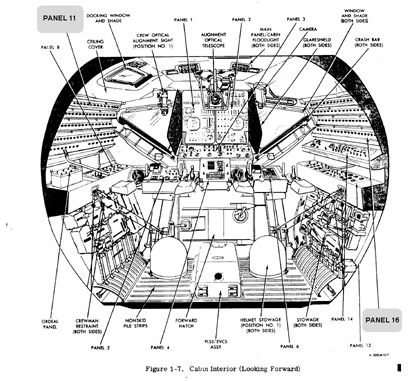
View of the front of the LM cabin
with the circuit breaker panels highlighted.
(Click on the image for a larger version.)
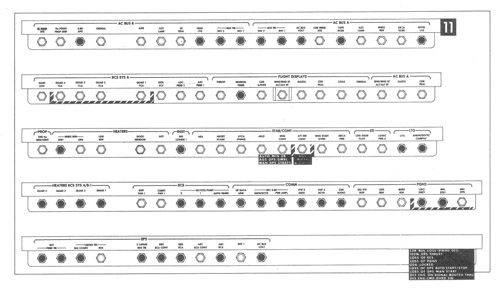
LM-6 (A12 / Intrepid) Circuit Breaker Panel CB(11).
Scan courtesy Paul Fjeld.
(Click on the image for a legible version.)
In the following sections, we consider the rows of breakers one at a time and compare the configurations for the six landing missions. Note that these configurations were taken from the LM Lunar Surface Checklists for the various missions. Breakers represented by completely black circles were to be closed while breakers represented by circles with white centers were to be open. The diagrams for the various missions are not necessarily from the same mission phase, so the fact that a breaker is black or white is not important to the comparison.
Circuit Breaker Panel CB(11) - Top Row
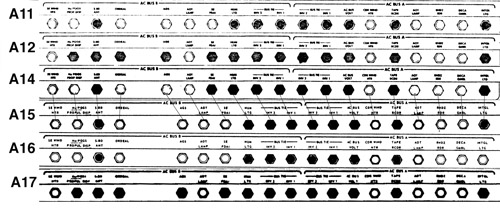
CB(11) top row for Apollo 11 (top) to Apollo 17 (bottom).
The contents of the top row was the same on all six missions.
The only change in the layout was more space between the
fourth and fifth breakers after Apollo 14 (third from the top).
(Click on the image for a larger version.)
Details of the Top Row:
From left to right, under a larger group "AC BUS B", the row started with a group of four breakers
- (1) SE WIND HTR - Systems Engineer (LMP) Window Heater,
- (2) He/PQGS; PROPUL DISP - Helium/Propellant Quanitity Gaging System; Propulsion Display
- (3) S-BD ANT - S-Band Antenna
- (4) ORDEAL - Orbital Rate Display, Earth and Lunar
Next, there is a gap on the panel and then the following four breakers:
- (5) AGS - Abort Guidance System
- (6) AOT LAMP - Alignment Optical Telescope Lamp
- (7) SE FDAI - Systems Engineer (LMP) Flight Director Attitude Indicator (also known as the "Eight Ball")
- (8) NUM LTG - Numerical Lighting
Then there are two final "AC BUS B" breakers under subheading "BUS TIE"
The righthand section of the row, under the heading "AC BUS A", begins with two breakers under subheading "BUS TIE"
followed by seven breakers
- (13) AC BUS VOLT
- (14) CDR WIND HTR - Commander Window Heater
- (15) TAPE RCDR - Tape Recorder
- (16) AOT Lamp - Alignment Optical Telescope Lamp
- (17) RNDZ RDR - Rendezvous Radar
- (18) DECA GMBL - Decent Engine Control Assembly Gimbal
- (19) INTGL LTG -
Circuit Breaker Panel CB(11) - Second Row
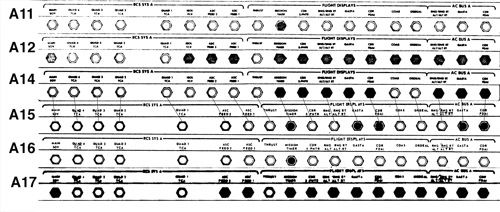
CB(11) second row for Apollo 11 (top) to Apollo 17 (bottom).
After Apollo 14 (third from the top), the RCS SYS A ISOL VLV breaker
- sixth from the left on the early missions - was removed
and the spacing between the fourth and fifth breakers increased.
(Click on the image for a larger version.)
Details of the Second Row:
There are eight breakers under the main heading "RCS Sys A", begining with a group of four breakers:
- (1) MAIN SOV - Main Shutoff Valve
- (2) Quad 4 TCA - Thrust Chamber Assembly
- (3) Quad 3 TCA - Thrust Chamber Assembly
- (4) Quad 2 TCA - Thrust Chamber Assembly
Followed by a gap and the final four "RCS Sys A" breakers:
- (5) Quad 1 TCA - Thrust Chamber Assembly
- (6) ISOL VLV - Isolation Valve (eliminated after Apollo 14)
- (7) ASC FEED 1 - Ascent Feed 1
- (8) ASC FEED 2 - Ascent Feed 2
The next group of eight breakers is under a new main heading, "Flight Displays":
- (9) THRUST
- (10) MISSION TIMER
- (11) CDR X-PNTR - Commander Cross-pointer
- (12) RNG / RNG RT, ALT / ALT RT - Range / Range Rate, Altitude / Altitude Rate. Note that, in the LM-6 CB (11) diagram above, this breaker is shown with guards on either side.
- (13) GASTA - Gimbal Angle Sequencing Transformation Assembly
- (14) CDR FDAI - Commander's Flight Director Attitude Indicator (also known as the "Eight Ball")
- (15) COAS - Crewman Optical Alignment Sight
- (16) ORDEAL - Orbital Rate Display, Earth and Lunar
The final major heading in the second row is "AC BUS A" and contains three breakers:
- (17) RNG / RNG RT, ALT / ALT RT - Range / Range Rate, Altitude / Altitude Rate..
- (18) GASTA - Gimbal Angle Sequencing Transformation Assembly
- (19) CDR FDAI - Commander's Flight Director Attitude Indicator (also known as the "Eight Ball")
Circuit Breaker Panel CB(11) - Third Row
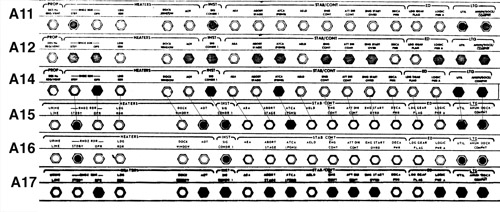
CB(11) third row for Apollo 11 (top) to Apollo 17 (bottom).
After Apollo 14 (third from the top), the lefthand breaker "DES He REG/VENT"
and its heading "PROP" were moved to the righthand end of the fifth row
(see below) and an additional heater breaker "Urine Line" was put in its place.
The spacing between the fourth and fifth breakers in row three increased.
(Click on the image for a larger version.)
Details of the Third Row:
For Apollo 11, 12, and 14, the first breaker had the main heading "Prop" :
- (1a) Des He REG/VENT - Descent Helium Regulator and Vent
After Apollo 14, this breaker was moved to the righthand end of the fifth row (see below), and the main heading "Heaters" was extended to include a replacement breaker:
On all six missions, the next two breakers were all under the main heading "Heaters" and a subheading "RNDZ RDR" (Rendezvous Radar);
- (2) STBY - Standby
- (3) OPR - Operate
The next breaker under the main heading "Heaters" was
- (4) LDG RDR - Landing Radar
with a space before the final two heater breakers
- (5) DOCK WINDOW - Docking Window
- (6) AOT - Alignment Optical Telescope
The next main heading, "INST" (Instrumentation) covered one breaker:
- (7) SIG CONDR 1 - Signal Conditioner
The next main heading "STAB/CONT" (Stability and Control) covered eight breakers:
- (8) AEA - Abort Electronics Assembly
- (9) ABORT STAGE
- (10) ATCA (PGNS) (Attitude and Translation Control Assembly (Primary Guidance and Navigation System
- (11) AELD - Ascent Engine Latching Device
- (12) ENG CONT - Engine Control
- (13) ATT DIR CONT - Attitude (and?) Direction Control
- (14) ENG START OVRD - Engine Start Override
- (15) DECA PWR - Descent Engine Control Assembly Power
The main heading "ED" (Explosive Device) covers two breakers:
- (16) LDG GEAR FLAG - Landing Gear Flag
- (17) LOGIC PWR A - Logic Power A
The final main heading in row three, "LTG" (Lighting) covers two breakers:
- (18) UTIL - Utility LIghts
- (19) ANUN/DOCK/COMPNT - Annunciator/Docking/Component LIghting
Circuit Breaker Panel CB(11) - Fourth Row
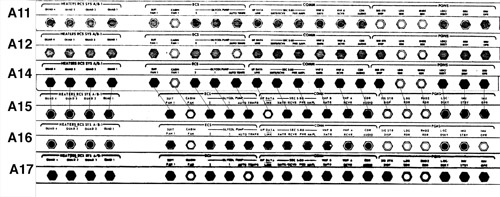
CB(11) fourth row for Apollo 11 (top) to Apollo 17 (bottom).
After Apollo 14 (third from the top), the spacing between the fourth and fifth breakers increased.
There were no other differences.
(Click on the image for a larger version.)
Details of the Fourth Row:
The first main heading on the lefthand end, "Heaters RCS Sys A/B-1" covers four breakers:
- (1) Quad 4
- (2) Quad 3
- (3) Quad 2
- (4) Quad 1
The second main heading "ECS" (Environmental Control System) begins with two breakers:
- (5) Suit Fan 1
- (6) Cabin Fan
Followed by three breakers under the subheading "GLYCOL PUMP":
- (7) 2 - Glycol Pump 2
- (8) 1 - Glycol Pump 1
- (9) Auto TRNFR - Auto Transfer
The next main heading, "COMM", begins with:
Followed by two breakers under the subheading "SEC S-BD" (Secondary S-Band):
- (11) XMTR RCVR - Transmitter Receiver
- (12) PWR AMPL - Power Amplifier
And three additional breakers:
- (13) VHF B XMTR - Transmitter
- (14) VHF A RCVR - Receiver
- (15) CDR AUDIO - Commander Audio
The final main heading in row four, "PGNS" (Primary Guidance and Navigation System, covers six breakers:
- (16) SIG STR DISP - Signal Strength Display (?)
- (17) LDG RDR - Landing Radar
- (18) RNDZ RDR - Rendezvous Radar
- (19) LGC DSKY - LM Guidance Computer Display and Keyboard
- (20) IMU STBY - Inertial Measurements Unit, Standby
- (21) IMU OPR - Inertial Measurements Unit, Operate
Circuit Breaker Panel CB(11) - Fifth Row
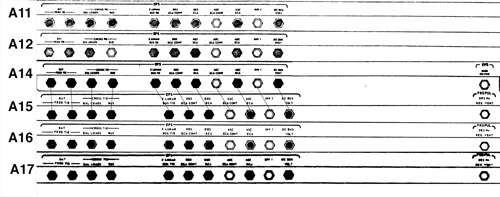
CB(11) fifth row for Apollo 11 (top) to Apollo 17 (bottom).
After Apollo 14 (third from the top), the spacing between the fourth and fifth breakers increased.
For Apollo 14 a breaker "EPS EMRG CM PWR" (Electrical Power System, Emergency Command Module Power) was added at the extreme righthand end of the row, undoubtedly in response to the Apollo 13 accident.
After Apollo 14, this was replaced with the "PROP, DES He REG/VENT" breaker moved from the lefthand end of the third row.
(Click on the image for a larger version.)
Details of the Fifth Row:
Except for the breaker at the extreme righthand end of the row for Apollo 14-17, all of the breakers in the fifth row are under the main heading "EPS" (Electrical Power Subsystem).
The row with two otherwise unlabeled breakers under the subheading "BAT FEED TIE":
- (1) BAT FEED TIE - Battery Feed Tie
- (2) BAT FEED TIE - Battery Feed Tie
These are followed by two breakers under the subheading "CROSS TIE":
- (3) BAL LOADS - Balance Loads
- (4) BUS
The remaining seven breakers under the "EPS" main heading are:
- (5) X LUNAR BUS TIE
- (6) DES ECA CONT
- (7) DES ECA
- (8) ASC ECA CONT
- (9) ASC ECA
- (10) INV 1
- (11) DC BUS VOLT
And the final breaker, from Apollo 14 onward on the far righthand end:
- (12a) EPS EMRG CM PWR - Electrical Power System, Emergency Command Module Power (Apollo 14 only)
- (12b) PROP DES He REG/VENT - Propulsion, Descent He Regulator/Vent (Apollo 15-17)
Journal Home Page






